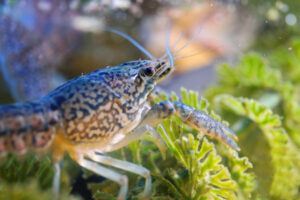
As an aspiring aquarist, you reach a point where you’re happy with managing your fish populations and start wondering what other creatures you could add to the tank/pond. Koi are not the most difficult fish to keep, but they are voracious eaters, limiting their “cohabitor list” to (mostly) other large fish. But what about hardy crustaceans? Can crayfish live with koi?
While it is possible to keep crayfish with koi, intervention and adequate management are essential. You must construct a suitable tank/pond environment to ensure your crayfish survive. Crayfish require sufficient hiding places, enough food, and population control to prevent fighting and injuries.
Although some aquarists keep crayfish and koi in the same pond/tank environment, it’s not common practice. Without careful care and management, these aquatic species are detrimental to each other. Below we’ll further investigate how to keep crayfish and koi together and some of the pros and cons of cohabitation.
Pro Tip: If you’re tired of wasting money and making costly mistakes on the koi-keeping hobby or are thinking about buying koi fish but don’t know where to start, I strongly suggest you check out this ebook. I recently read this ebook, and it contains SO much useful information, such as:
- 3 proven steps to identify koi fish diseases
- WARNING: 3 things you should NEVER do when it comes to caring for koi
- When to seek professional help when it comes to looking after your koi
Crayfish And Koi Tank/Pond Mate Compatibility Explored
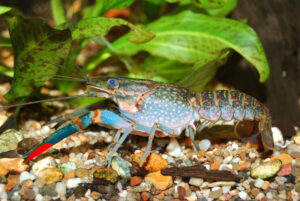
While most things are possible, not all things are beneficial (to the aquarium or the aquarist). Most koi owners don’t want the added stress of managing crayfish in their koi ponds and prefer to keep crayfish-free ponds.
Although crayfish and koi can co-exist, they won’t if left to self-regulation. I.e., you’ll need to devote significant time and energy to establishing a suitable environment where both species thrive and continue to manage the environment.
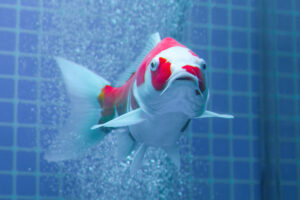
You risk losing one or both species from the pond if you don’t stay on top of the koi and crayfish populations.
The two areas of management critical to the success of your pond/tank are habitat suitability and interspecific relationships (how the crayfish and koi interact with each other).
Can Crayfish Live In A Pond?
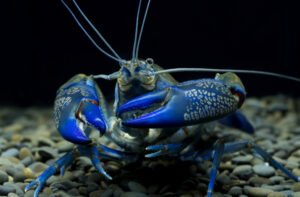
As for the habitat requirements, crayfish and koi thrive in a pond environment, provided the conditions are suitable.
Ideal Tank Conditions For Crayfish Vs. Koi
Crayfish (Procambarus clarkii), also known as crawdads, mudbugs, and crawfish, are freshwater crustaceans (in the Cambaridae family).
In stagnant water situations, crayfish may suffocate through a lack of oxygen. Crayfish do not swim around the pond, preferring to remain in a particular area, which leads to oxygen depletion at greater depths.
When keeping crayfish in a tank or standing water body, most experts recommend that they remain at a depth of around 6″ to ensure enough oxygen availability.
On the other hand, koi require roughly 3 to 4-foot-deep water, which is potentially too deep for crayfish.
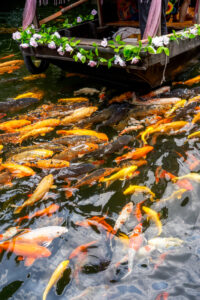
Ponds should have adequate filtration, oxygenation (and air stone), and levels (rocks, a sloped floor, logs, vegetation, etc.) to circumnavigate the issues around stagnation. By including a water feature or proper pump system, you’ll provide a current to your pond.
However, crayfish are renowned climbers who may escape from the pond on pipes and shallow regions, so block off all exit routes.
Crayfish reproduction is linked to fluctuating water levels/conditions, which, in most ponds, is a naturally occurring event. By maintaining constant water conditions, you’ll discourage population blooms.
Although crayfish and koi survive in colder water, a crayfish’s preferred temperature range is 68° to 75°F. Koi’s ideal range is 59° to 77°F.
The Size Of The Pond/Tank Is Equally Important
Keeping koi and crayfish together follows the same principle as keeping any different aquatic species together. They need space.
You’ll need roughly 1 square foot of space per pair of medium-sized crayfish. Although koi swim and crayfish are benthic (bottom-dwellers), you’ll need enough space to reduce stress and predation/fighting between fish and crayfish.
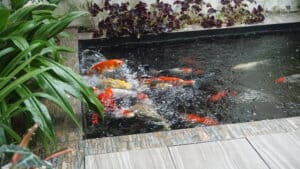
If you have a smaller pond/tank, the incidents will increase, and the critters will become aggressive.
A koi pond should be a minimum of 1000 gallons to promote optimal living conditions. Anything under 1000 gal and you will have issues as the fish and crayfish compete for resources (including space).
If you want to add more aquatic organisms, you need a larger tank/pond.
If you want to know more about what animals can live with Koi, I recently wrote a few blog posts about this subject that you can read here:
Can glofish live with Koi
Can bass live with Koi fish
Can Angelfish live with Koi
Can African dwarf frogs live with Koi fish
Can parrot fish live with Koi fish
Do Koi Fish Eat Crayfish?
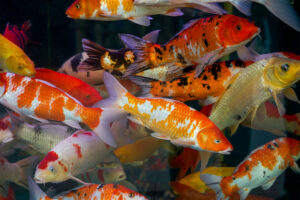
One of the most significant issues you’ll face when keeping crayfish and koi is that koi eat crayfish. Koi are omnivore’s who often forage in muddy substrates for food, putting crayfish on the menu.
While most koi are accustomed to fish pellets, a “natural” diet for koi consists of the following:
● Algae
● Tadpoles
● Water plants and plant parts
● Worms
Almost anything that fits into a koi’s mouth is fair game as food.
How Do I Stop Koi From Eating All The Crayfish?
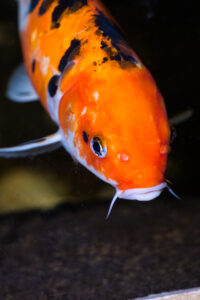
It’s important to note that koi will eat some crayfish in the pond (unless you section off an area devoted to crayfish).
In an open pond (free movement across the whole pond), you must construct your pond/tank to create sufficient hiding places to prevent your koi from decimating the crayfish population.
The most effective hiding places are rocks, logs, submerged pond plants, plastic pipes, and a muddy substrate (for burrowing).
Do Crayfish Eat/Hurt Koi?
While koi pick off whatever crayfish they can swallow, the crayfish are not the only residents at risk. Crayfish often eat smaller fish, so in greater numbers, crayfish can reduce baby and small koi numbers.
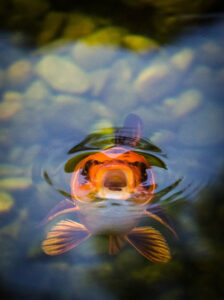
When there is a food shortage, crayfish become aggressive to the koi fish (including larger fish).
Crayfish are non-selective omnivores and eat various food items, including:
● Decomposing vegetation
● Insects
● Small fish and crustaceans (including their decomposing parts)
● Worms
It is essential to maintain healthy crayfish numbers in the pond. Once they become overpopulated, your pond/tank may experience a severe decline.
The Pros And Cons Of Keeping Crayfish With Koi
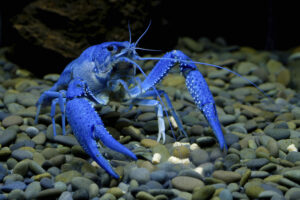
If you’re undecided about adding crayfish to your koi pond/tank, read through some of the advantages and disadvantages of keeping them together to help make your decision.
The Pros Of Keeping Crayfish With Koi
● Crayfish are detritivores, meaning they eat rotting animal and plant materials in the tank, helping to keep it clean.
● When kept in adequate numbers, crayfish are an additional food source for koi (providing enrichment and reducing upkeep costs).
● Crayfish eat living plant material and maintain pond vegetation levels (including algae) in controlled amounts.
● Crayfish are a popular human cuisine. Although most of us don’t think about eating what comes from our koi pond, you could “farm” crayfish, which is an effective management solution when you need to reduce the population.
● Crayfish add a unique element to your pond; some varieties have fantastic colors, enhancing the aesthetics.
The Cons Of Keeping Crayfish With Koi
● In greater numbers, crayfish may deplete oxygen levels in the pond, harm/eat smaller fish, and fight with larger fish.
● If your tank is not correctly set up, your koi may eat all the crayfish (not enough hiding spots). Alternatively, your crayfish may die if the oxygenation is inadequate.
● Although crayfish burrows hardly ever cause structural damage to the pond (like bank erosion), there are instances where they might.
● Crayfish may eat water plant roots, resulting in a die-off of these plants (in large numbers if there is a crayfish overpopulation).
● Crayfish are fond of snails. While they help maintain a balanced ecosystem, too many crayfish will decimate the snail population, which could result in algal blooms.
Conclusion
While it is possible to keep crayfish and koi together, most aquarists prefer not to. Crayfish require relatively intense management to ensure they don’t damage the pond or harm the koi. Although not typically aggressive, crayfish attack koi when food is limited. To effectively keep crayfish and koi, you’ll need a large pond, sufficient hiding places, and control of the crayfish population.
Related blog posts:
Can Axolotls Live With Koi Fish?
Can Arowana Live With Koi?
Can Shubunkin Live With Koi?
Can Koi And Turtles Live Together?
Best Catfish For Koi Pond
References
https://www.carolina.com/teacher-resources/Interactive/care-guide-crayfish/tr10489.tr#:~:text=Use%20conditioned%20tap%20water%2C%20spring,for%20air%2C%20they%20may%20suffocate. https://a-z-animals.com/blog/what-do-koi-fish-eat-8-key-foods-in-their-diet/

